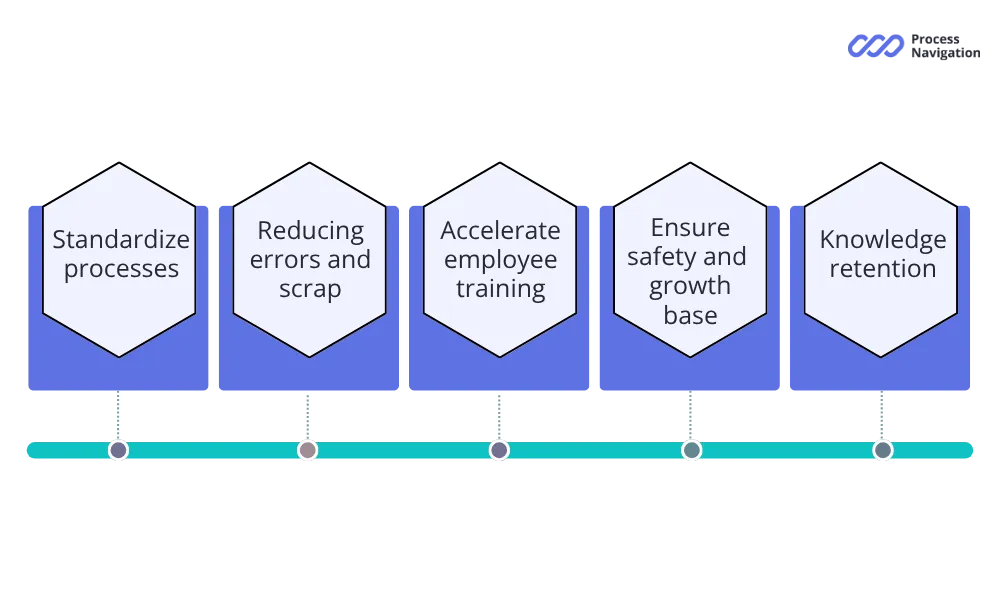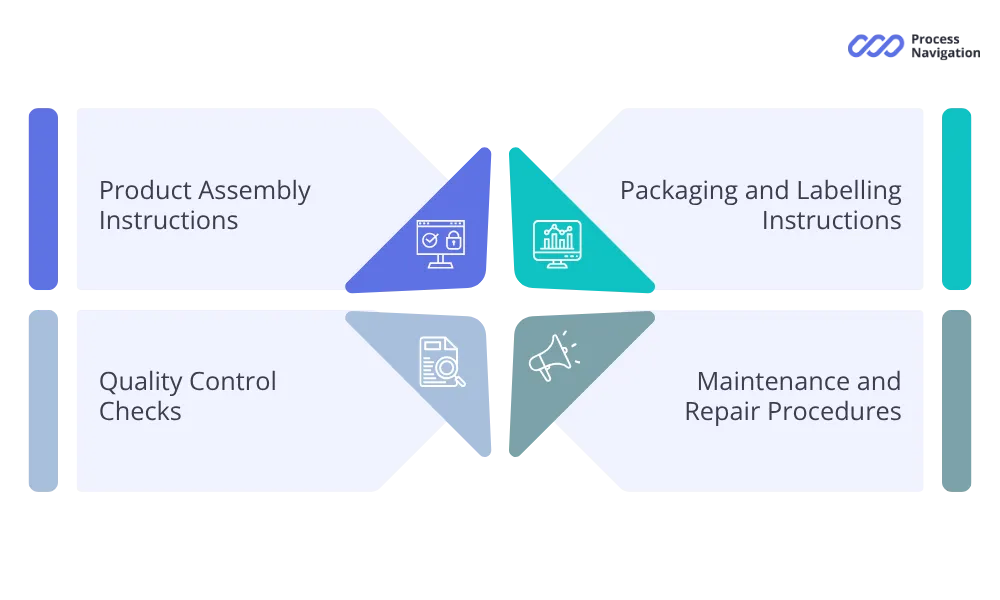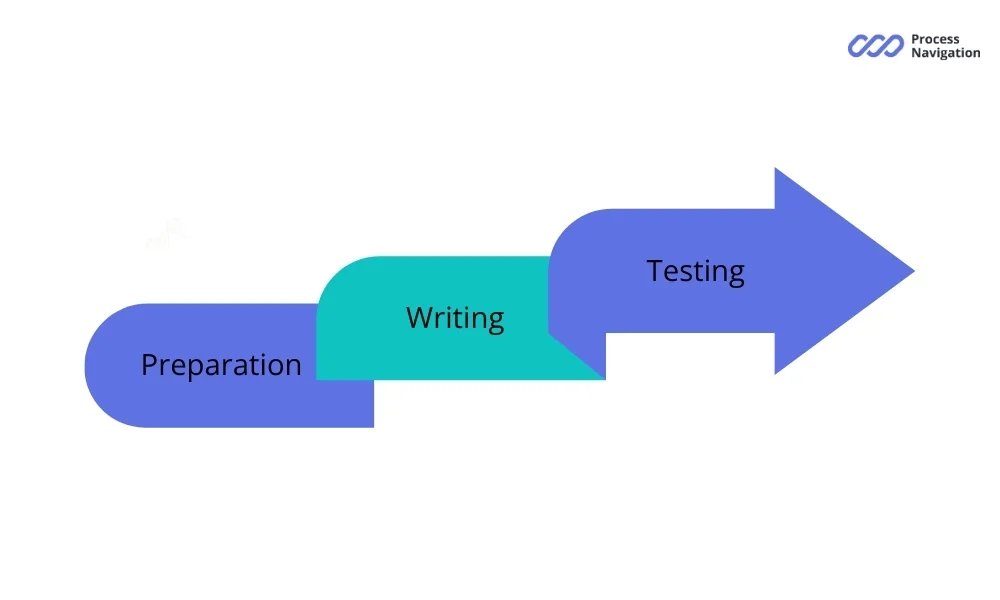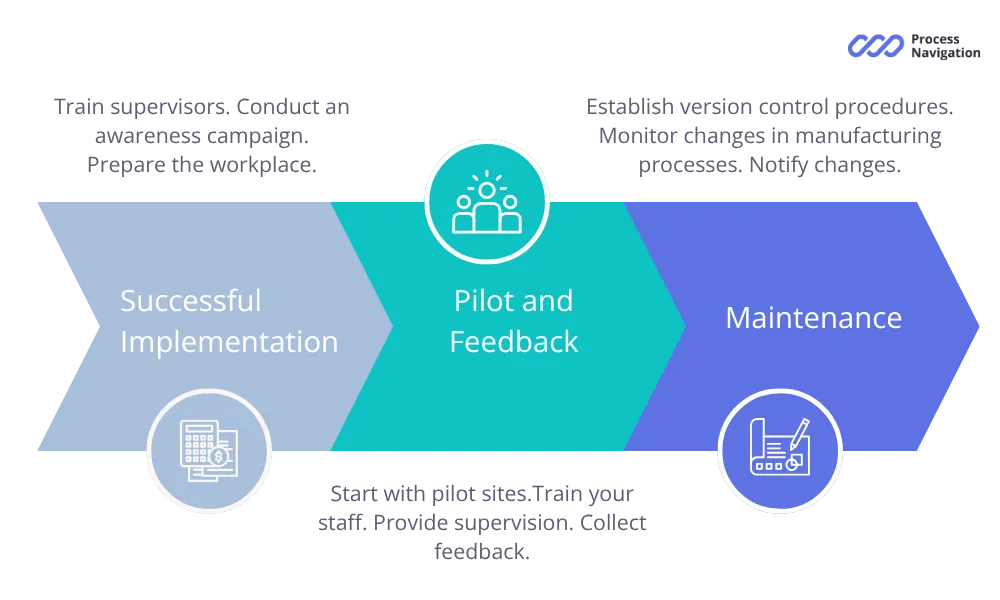Imagine the situation: new employees come to the assembly line and are told to “watch how others do it and repeat it”. Unfortunately, many companies still operate in this way.
This approach significantly increases the risks of production defects, production errors, and accidents in manufacturing processes. The main reason is the lack of standardized work instructions.
This is not just a piece of paper for a tick, but a real tool that can effectively change the manufacturing work of the enterprise.
What Are Manufacturing Work Instructions
A manufacturing work instruction is a detailed introduction describing how to perform a particular task in production, including emergency situations. It describes the step-by-step process to be performed in the workplace and is mandatory for certain types of manufacturing work, especially at hazardous industrial facilities.
The main purpose of work instructions is to ensure that any trained employee can do the job correctly, safely and with the right quality. Regardless of experience, mood or personal preference.
It is not a formality, but a key tool that ensures the stability of manufacturing processes, labor safety, and a common understanding of tasks among all employees.
Well-written work instructions answer the questions:
- What should be done?
- In what sequence?
- What tools should be used?
- How to ensure safety?
- What to do if something goes wrong?
Here are the main reasons:

- Standardize Processes
When each team member has a different approach to performing tasks, the result is unpredictable. One does it quickly, but with defects. Another one does it slowly but with quality.
Work instructions solve this problem. They set a common standard of manufacturing work, which allows to get a stable result regardless of who performs the operation. This leads to enhancing efficiency and helps standardize work across the shop floor.
- Reducing Errors and Scrap
Human memory is imperfect. Even an experienced employee can forget a step or confuse the sequence of actions. Especially when the manufacturing work is complex or rarely performed.
The work instructions serve as a hint and a checklist. They define sequential steps clearly and help reduce production errors.
- Accelerate Employee Training
Without work instructions, a newcomer has to learn by trial and error or rely on the explanations of colleagues. This is time-consuming, inefficient and prone to mistakes.
With good manufacturing work instructions, the learning process becomes structured and predictable. The new employees get up to speed faster and start working independently on the assembly line.
- Ensure Safety
Manufacturing often involves risks. Incorrect actions can lead to injuries, accidents or damage to equipment.
Work instructions contain important information on safety precautions, the correct use of personal protective equipment and what to do in emergency situations. Proper procedures help prevent accidents in manufacturing work.
- Knowledge Retention
When an experienced employee leaves, knowledge and skills go with him. If this knowledge is not captured in instructions, the company loses it.
Properly written manuals help retain the best practices and passing them on to the next employees working in manufacturing operations.
- Basis for Improvement
To improve a process, you must first understand how it works now. Work instructions are the starting point for analysis and optimization.
When the process is clearly described, it is easier to find bottlenecks, redundant operations or opportunities for automation. This supports continuous improvement initiatives.
How Manuals Are Used in Manufacturing: Examples
Let’s see how manuals are used in practice:

- Product Assembly Instructions: These instructions will include steps such as a description of kit parts, sequence and method of assembly, as well as tips.
- Packaging and Labelling Instructions: In industries like pharmaceuticals or food production packaging and labelling must follow strict guidelines to ensure product safety and compliance. Work instructions in these areas will include step-by-step instructions on how to pack items, apply the right labels and ensure the packaging is secure for shipping. These instructions are critical to ship products safely.
- Quality Control Checks: In any production process quality control is part of keeping high standards. Work instructions in this area will include instructions for visual inspection, measuring product dimensions, and testing products. These instructions will detect defects early and fix them before they reach the customer.
- Maintenance and Repair Procedures: If a piece of equipment on the production line breaks workers will refer to maintenance work instructions. These will include troubleshooting steps, instructions to replace parts or how to clean and lubricate the machinery. Well-written work instructions for manufacturing means repairs are done faster and better, less downtime.
Types of Manufacturing Instructions
Different manuals serve various purposes:
| Criterion | Type | Goal |
| By appointment | Operating instructions | Describe how to perform specific manufacturing operations. For example, how to set up a machine or how to package a finished product. |
| Safety instructions | Contain rules for working safely with equipment, materials or in hazardous conditions. They include safety guidelines and prevent accidents. These instructions are mandatory for all workplaces where there are health risks for workers. | |
| Maintenance instructions | Regulate scheduled maintenance through detailed procedures: lubrication, replacement of consumables, inspection of assemblies. | |
| Quality control instructions | Regulate procedures for checking products for compliance with industry standards. Includes inspection methods, evaluation criteria and actions in case of quality issues. | |
| According to the level of detail | General instructions | Describe the process in general, without too much details. Suitable for experienced employees who understand basic procedures. |
| Detailed instructions | Contain a step by step description of each action. Necessary for complex tasks or when working with new employees in manufacturing work. | |
| Quick notes | Capture only key points. Use as a reminder or in addition to the main work instructions. | |
| By form of presentation | Text instructions | Classic variant in the form of a numbered list of actions. Simple to create, but can be difficult to understand without visual aids. |
| Instructions with illustrations | Contain diagrams, photos, drawings that explain the text. Enhance visual perception with visual aids. | |
| Video instructions | Show the process in dynamics. Particularly effective for employee training, but more difficult to create and update. | |
| Interactive instructions | Allow to select sections, follow links, get hints. Requires special software but provides better user experience. |
Digital Work Instructions
Traditional paper-based instructions are gradually giving way to digital solutions. Modern tools offer many benefits for manufacturing work:
- Interactive Elements. Digital work instructions can contain videos, animations, and interactive features. This makes them more visual and understandable for manufacturing operations.
- Quick Updates. A digital work instruction can be changed in minutes. All users automatically receive the current version, which saves time during updates.
- Usage Control. Systems can track who used the work instructions and when, how much time was spent studying specific procedures.
- Integration with Other Systems. Work instructions can be linked to planning, quality control, personnel management systems.
- Mobile Device Compatibility. Modern digital instructions work on smartphones and tablets, making them accessible anywhere on the assembly line.
Structure of Work Instructions
A well-organized guide typically includes:
| № | Section | Contents |
| 1 | Title information | Includes document name, number, date, author, and version (version control). |
| 2 | Purpose and scope of application | This section briefly explains what the work instructions are for and where they apply in manufacturing work. |
| 3 | Materials required and tools required | A complete list of everything you will need to do the job: – tools and implements – materials needed and blanks – measuring tools – personal protective equipment – supporting documentation. |
| 4 | Safety requirements | This section should be in every manual, even if the job seems safe. Includes: – general safety rules – safety guidelines – requirements for protective equipment – actions to be taken in emergency situations. |
| 5 | Step-by-step description of the process | The most important part of the work instructions. Each step must be: – numbered – described in simple and clear language – contain specific tasks, not general phrases. |
| 6 | Quality control | A description of how to check that the manufacturing work is done correctly: – what to check – how to check – what the results should be. Includes quality checks to ensure product quality. |
| 7 | Possible problems and their solutions | A list of typical problems that may arise during the operation and how to correct them. This section is particularly valuable because it contains practical experience and helps address quality issues. |
[Download Manufacturing work instruction template free]
Creating Manufacturing Work Instructions

- Preparation
Define the purpose of the work instructions. Clearly state what the employee should be able to do after reviewing the document. This will help to avoid getting distracted by minor details when performing manufacturing work.
Study the process. If you are not an expert in the field, be sure to talk to experienced workers. Observe the operation several times, ask questions about procedures and manufacturing operations.
Consult industry standards. Find out the requirements of standards, specifications, safety rules. The work instructions must comply with them to ensure quality assurance.
Consider the target audience. Work instructions for an experienced employee will be different from instructions for a beginner. Take into account the level of knowledge and skills of users performing manufacturing work.
- Writing
Start with a plan. Make a general outline of the work instructions, identify the main sections. This will help to structure the information and not to miss anything when documenting manufacturing operations.
Write in simple language. Avoid complex terms without explanation, long sentences and clericalisms. Remember: the work instructions must be understandable to everyone. Use clear instructions that any team member can follow.
Number step-by-step instructions. Each step should have its own number. This helps not to get lost in the process and discuss specific points about manufacturing work.
Add visual elements and interactive elements. One picture often replaces a paragraph of text. Use diagrams, photos, drawings to explain complex points in manufacturing instructions.
- Testing
Practice test. Ask someone else to perform the operation strictly according to the work instructions. This will help identify missing steps and inaccuracies in procedures.
Get feedback loop. Show the work instructions to experienced employees and beginners. Their comments will help improve the document and ensure workers understand the process.
Conduct a pilot implementation. Test the work instructions in real conditions on a small group of employees before mass implementation in manufacturing operations.
Common Mistakes when Drafting Work Instructions
Here are the most frequent errors to avoid:
| Mistake | Example |
| Too general wording | General phrases do not give specific information about what to do in manufacturing work. Incorrect: “Ensure quality machining of the part”. Correct: “Finish the surface to a roughness of Ra 3.2 µm, check with comparison samples”. |
| Skipping the obvious steps | What seems obvious to an experienced worker may not be clear to a novice. For example, forgetting to write “turn on the machine” or “wear safety glasses” in manufacturing instructions. |
| Incorrect sequence | Sometimes the author of the manual describes the detailed steps in the wrong order or forgets to mention preparatory operations. |
| Ignoring security issues | Even the simplest operation can have risks. Do not ignore safety requirements in work instructions, even if they seem obvious. |
| Using of professionalisms and jargon | Professional slang is understood only by the initiated. Explain special terms or use common names in manufacturing work documentation. |
| Lack of illustrations | Many processes are difficult to describe in words. The wiring diagram, the location of the controls, the correct position of the part — all this is better shown in a drawing within work instructions. |
Platforms for Creating Work Instructions
There are different types of solutions to choose from:
- Office applications — Microsoft Word, Google Sheets, Google Docs. Easy to use, but limited in functionality for complex manufacturing instructions.
- Knowledge management systems — corporate wikis, knowledge bases. Allow you to create structured collections of searchable and cross-referenced documents for manufacturing work.
- Work instructions software applications — allow you to create instructions adapted for viewing on mobile devices. They are especially convenient for employees who move around the territory of the enterprise.
- Specialized systems — programs created specifically for creating work instructions. They contain ready-made templates, tools for creating schemes, and opportunities for teamwork in manufacturing operations.
One such tool is ProcessNavigation. It’s an easy-to-use platform where you can create digital instructions and add photos, videos, and even voiceovers. Employees receive ready-made instructions directly on their phones. QR codes can be placed on equipment — just scan one, and the right instruction opens instantly.
Instructions by ProcessNavigation include:
- Step-by-step prompts.
- Photo or video examples of how to perform tasks correctly.
- Quick quizzes to check understanding.
What companies gain as a result:
- Switching to digital work instructions significantly boosts operational efficiency: defect rates drop by 25–40%, quality and safety compliance rises by 30–60%, and the risk of data leaks falls by 70–90%.
- Onboarding accelerates by 60–80% (from two weeks to just three days), with adaptation time reduced by 30–50%, training speed up by 20–35%, and mentor workload down by 25–45%. Rotation time decreases by 75–95%, while finding responsible staff is 50–75% faster.
- Task completion on schedule improves by 20–35%, reporting becomes 30–50% more complete and timely, and managers spend 35–60% less time on operational control. Data collection is 40–70% faster and more accurate, audits take 35–55% less time, and employee productivity rises by 15–30%.
These kinds of solutions work especially well in lean manufacturing environments, where clear processes, fewer errors, and fast employee onboarding are crucial. ProcessNavigation is a simple and practical way to bring order, reduce waste, and improve quality without unnecessary paperwork or bureaucracy.
Implement and Update Work Instructions
This process involves several key steps:

- Successful Implementation
Train supervisors. Site supervisors and foremen must understand the importance of work instructions and know how to use them in daily manufacturing work. They will be the agents of change for manufacturing teams.
Conduct an awareness campaign. Explain to employees why work instructions are needed and how they will help them in their manufacturing work. Overcome resistance to change.
Prepare the workplace. Make work instructions available at workplaces. This can be stands, tablets or computer terminals on the shop floor.
- Pilot and Feedback
Start with pilot sites. Do not implement the work instructions all over the enterprise at once. Select a few key areas to practice the process.
Train your staff. It is not enough to simply hand out work instructions. Provide training, show how to use them, answer questions about procedures.
Provide supervision. Supervisors should check to make sure employees are using the work instructions and understanding them correctly when performing manufacturing work.
Collect feedback. Regularly survey workers about the usability of the work instructions, and get suggestions for improvement. This saves time and improves effectiveness.
- Maintenance
Establish version control procedures. Determine who is responsible for keeping work instructions up to date, how often they need to be reviewed, and how to make changes.
Monitor changes in manufacturing processes. Any changes in technology, equipment, or requirements should be reflected in the work instructions.
Notify changes. All users of the manual should be informed of revisions and receive the latest versions of the documents.
Best Practices
Creating manufacturing work instructions requires time and effort, but it pays off many times over. The main thing is to remember that work instructions are created for people, not for inspectors. They should be clear, useful and user friendly.
Good manufacturing work instructions are living documents that evolve with the process. Update them regularly, gather feedback from users, and look for opportunities for development through continuous improvement practices.
When you write standard work instructions, consider these factors:
- Make them accessible to all manufacturing teams.
- Ensure they address potential customer satisfaction problems.
- Include all necessary materials needed for each operation.
- Provide clear instructions for each particular operation.
- Detail the sub operations within complex processes.
- Specify quality checks for the final product.
FAQ
Job descriptions are not the same as flow charts or job descriptions. Work instructions are more detailed and specific for manufacturing work. If a job description says “ensure product quality”, work instructions will describe exactly how to do this: what parameters to check, with what tools, at what intervals. To put it simply, job descriptions describe roles, and work instructions describe specific tasks in the production process.
Manufacturing work instructions are not just a formality or a requirement of a standard. They are real tools for increasing production efficiency, which help to: standardize procedures and reduce errors, support employee training, preserve knowledge and best practices, ensure workplace safety, and create a basis for improvement. Digital work instructions and proper creating work instructions empower businesses to meet modern production demands efficiently and boost productivity.
Start small: select a few operations, create work instructions for them, test and refine them. Gradually expand the scope, improve approaches, and introduce new technologies. Focus on manufacturing operations that are critical to product quality and involve quality inspectors in the review process. Consider implementing standard work instructions that can help ensure workers follow consistent procedures across all sub operations to ship products successfully and maintain high standards for the final product.
Work instructions should have: – A clear and descriptive name. – The reason why the task is done. – Easy-to-follow steps showing how to do the job. – Pictures, diagrams, or charts to help explain the steps visually.
-
 Maintenance Plan: What Is It And How Does It Work
Maintenance Plan: What Is It And How Does It WorkIn modern manufacturing, equipment downtime costs businesses thousands of dollars an hour. The difference between...
Technology
-
 Competency Management
Competency ManagementModern businesses face a big challenge: how do you ensure every employee has the skills...
Technology
-
 Unlocking the Benefits of Total Quality Management
Unlocking the Benefits of Total Quality ManagementIn today’s competitive world, the quality of products and services is becoming the key to...
Technology
